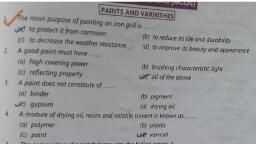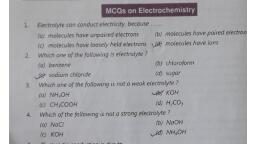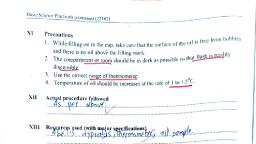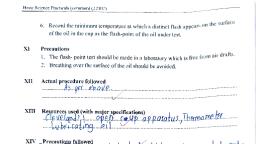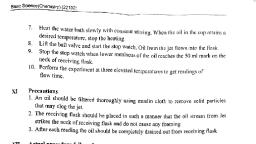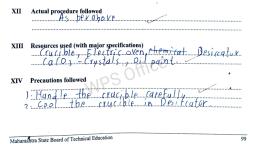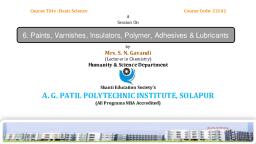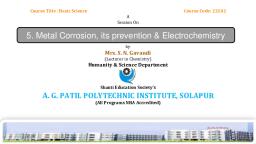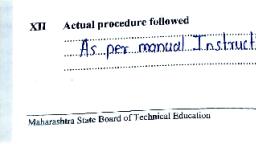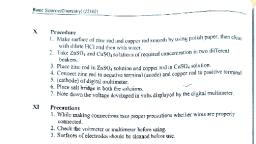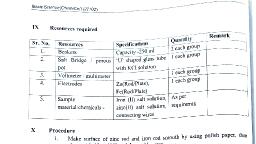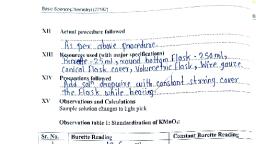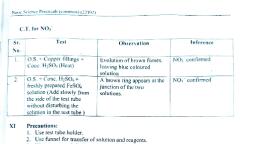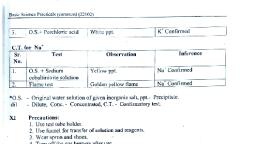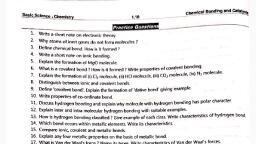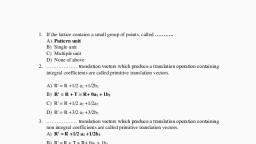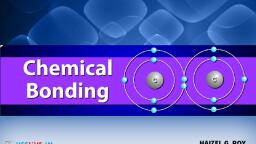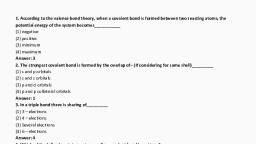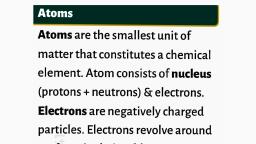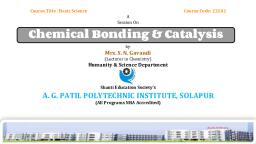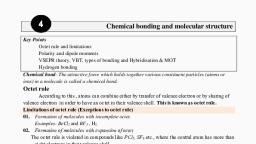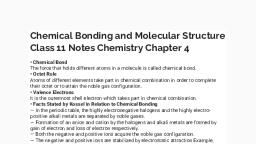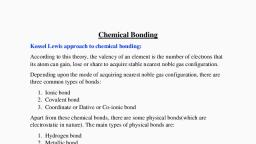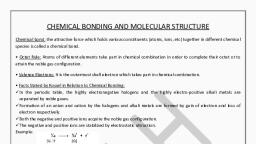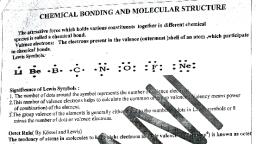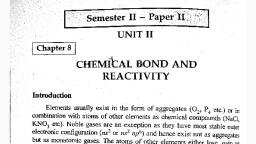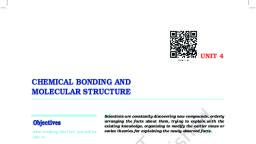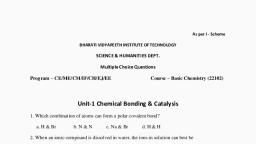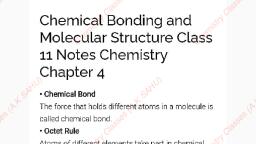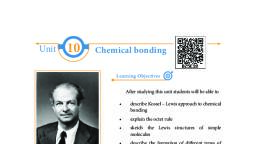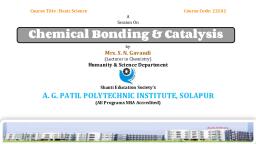Page 1 :
(a) ionic bond (b) covalent bond, (eX co-ordinate bond (d) dative bond, Metals lose electrons from their lattice to become ......, , . 4) positive ions (b) negative ions, (oc) alkalies (d) non-metals, , 35 Differentiate between promurers anu, , MCQs on Chémical Bonding and Catalysis, , “omplete transfer of one or more electrons between atoms constituting in forming, , , , Campi, , \4T ionic bond (b) covalent bond, ©) co-ordinate bond (d) dative bond, When single atom provides both electrons which are needed for completion of covalent, bond then it leads to ......, , in ammonium ion, electrons required between hydrogen ion and nitrogen ion are ......, (9) 1 by 2, , , , , , , , , , () 3 (d) 4, Dative covalent bond is found in......, (a) ammonia oF ammonium ion, (c) urea (d) nitrogen, Pairs of outer shell electrons not used in bonding are called as ......, (a) valence electrons (b) donor electrons, (¢) electrovalent electrons Ud lone pairs, Charge on any ion depends upon gain or loss of ......, Saf electrons (b) protons, (¢) neutrons (d) nucleons, Bond formed by sharing of four electrons is called as ......, (@) covalent bond (b) electrovalent bond, (Q dative covalent bond Vd double covalent bond, , For dative covalent bonding, one atom having a lone pair of electrons combines, , ys an electron deficient compound (b) an expanded octet, (9 aproton of other atom (d) a neutron of other atom
Page 2 :
ST tome wee :, , 10, , 18, , 19, , 20., , 21., , 22., , When the bond is formed by sharing of two pairs of electrons by atoms, then the bond is, called as ., , , , , , (a) single covalent bond — double covalent bond, ©) triple covalent bond (d) tonic bond, Neither ions nor electrons are free to move in, (a) liquids (b) metals, id wont solids (d) all of the above, nls and non-metals combine to give electronic configuration of .....a) alkates tb) noble gases, ©) metalloids (d) acids, Weok forces between molecules are called as ......, @) molecular forces _y) intermolecular forces, ©) intramolecular forces (d) extramolecular forces, Noble gases exist as ......, (a? monoatomic (b) diatomic, (co) polyatomic (d) none of these, Electrons are usually lost by ......, (ay metals (b) non-metals, (¢) inert gases (d) all of the above, In nitrogen molecule, number of electrons required by each nitrogen atom in outer shell, are......, (a) 1 (b) 2, or3 (d) 4, , When magnesium reacts with oxygen, nature of the bond formed is ......, (ay ionic (b) covalent, , () metallic (d) dative, , Metals are good conductors due to ......, (a) ionic lattice, , (c) mostly solids, Physical properties of bon, , (b) crystalline lumps, 4d) localized electrons, ding are influenced by bonding between ........., , (a) atoms (b) ions, , () molecules df all of the above, , Conduction of electricity in metallic bonding is due to the presence of ......, (b) lattice, , (a) protons, oy delocalized electrons, , Attempt in ionic bond formation Is .....-..(a) to get rid of excess electrons bf to attain configuration of noble gases, , (co) to avoid further reaction (d) all of the above, When a covalent bond is formed between hydrogen atom and a very electronegative, atom, then it is Known @s ....-(a) ionic bond, , (9 co-ordinate bond, , (d) nucleus, , tb hydrogen bond, (d) all of the above
Page 3 :
Mao OUISIILS . Vignes, , 23. Metal atoms ......, (a) lose their outer electrons, (©) became negatively charged, , 24. Nitrogen molecule is an example of..., (a) aoe covalent bond (b) double covalent bond, , (b) become positively ¢ harged, , (d) ‘both (a) and (b), , (d) single co-ordinate bond, closely packed together is called a, (by lattice, (d) none of the above, , ouble or triple line is done in..., (b) co-ordinate bond, , (d) ionic bond, , (ce) triple covalent bond, 25. Regular arrangement in which atoms are, (a) tetrahedral structure, (O) crystal lattice, 26. Representation of bond by a single, d, (a) metallic bond, _ (oe) covalent bond, _ 23 Covalent compounds are ......, (a) good conductors of electricity, , (Q) poor conductors of electricity, 28. Resulting a loss of electrons (e ) forms ......, , (b) non-conductors of electricity, (d) none of the above, , (a) anodes (b) cathodes, (c) negative ions _(d) positive ions, 29. Molecules which have permanent dipole are known as ......, fay polar (b) dipolar, (©) non-polar (d) tripolar, 30. Flectrovalent bond is another name of ......, (a) metallic bond (b) covalent bond, bey ionic bond (d) co-ordinate bond, , 31. When molecule is formed by chemical bonding. then, (a) nucleus of combining atoms participate, 4 valence electrons of combining atot, (©) valence electrons and inner cel, (d) none of the above, 32. Which statement is incor rim, (a) there is attraction between d, _-6) directional property is show), () delocalized electron can chai, (d) explanation of metallic, 33. Which of the following char, (a) luster, (b) ductility, AMO increase in cond, (d) malleability
Page 4 :
34, , 3s, , w, wo, , 40., 4., 42., 43., , 44. The sharp melting point of crystalline solids is, , sey rie Wweneny ore, , , , On which factor, conductance of metals is responsible ?, (a) sons (6) delocalized electrons, (2) atomic kernel (d) number of atoms, , The difference between the number of atoms in a unit cell of a BCC crystal and an FCC, crystal is, , =) ? es, fa) J mS (by 2, ( 4 (d) 6, ( Reason : The number of atoms per unit cell in BCC crystal is 2. The number of atoms per, ume cein FCC crystal is 4. So difference is 4 —2 = 2, When partial positive end of one molecule is attracted weakly to partial negative end,, then the force between them is, , (a) electrostatic force (by dipole-dipole interaction, (2) tonic bond (d) none of the above, Tendency of atoms to acquire eight electrons in their valence shell is ......, (a) octet rule (b) duplet rule, , (Q triplet rule (d) all of the above, , To form anion, non-metal atom ......, , (a) looses electrons (4) gain electrons, , (2) looses protons (d) gains protons, , When two identical atoms share electron pairs and exert force on each other then the, bond formed is ......, , \(@ non-polar covalent bond (6) polar covalent bond, (Q double covalent bond ‘(@) ionic bond, Crystal lattice is actually ......, (a) sum of points 4) array of points, , , , , , , , , , , , , (©) lines of points (d) triangles of points, in crystal lattice, particles are arranged in ...... f, (a) two dimensions (b) four dimensions, JO three dimensions (d) single dimensi, Unit cell is the smallest building unit of ...... one, t lattice iquids, = (d) none of, Which of the following is an amorphous solid ?, (a) diamond 6) glass, (Q) sodium chloride @
Page 5 :
ery Verenrwee ) eyperey, , ive i ( racteristi,, 45. Solids which have array of positive and negative \ons arranged in a cha ristic oul, throughout the crystal lattice are known as ......, , , , i) ionic solids (b) covalent solids :, () molecular solids (d) metallic solids ‘, 46. The lattice site in a pure crystal cannot be occupied DY. vseees :, (a) molecule (b) ton, <I electron (d) atom, , 47. The co-ordination number of BCC structure is ......, (a) 4 MI 8, () 2 (d) 12 i, 48. Substances which alter the rate of chemical reaction without undergoing any chemical, change are called as ......, , , , , , , , , , , , , , , , , , , , (a) polymers bby catalysts, (©) products (d) none of the above, 49. The process in which catalyst has a different phase to a reaction mixture is known as ..,, (a) homogeneous catalysis (b) hypergeneous catalyst, UI heterogeneous catalysis (d) hypogeneous catalyst, 50. The substances that reduce the effectiveness of a catalyst are called ......, (a) promoters (b) autocatalysts, AE inhibitors (d) none of the above, OE A catalyst cannot affect......, Nf products ' (b) rate of reaction, AE reactants Kd) both (a) and (b), , 52. When catalyst and reactants are in the same phase then it is called, 4am homogeneous catalysis (b) heterogeneous catalysis, , () autocatalysis (d) catalysis, oo When a product acts as a catalyst then it is called as, , (a) self catalysis (b) positive catalysis, LF autocatalysis (, , ‘d) negative catalysis, , 1(a) | 20 | 3.(a) | 4, >) 15.0) | 6@ 17, , f (a) | 8. (d), 11.(¢) | 12. (b) | 13, (b) | 14. (a) | 15, (a) | 16.) | a7, @ | 18. @), STL 22.) | 24.6 | 25. (6) | 26. (@) | 27.0) 28. (d), , 2. 32. (b) | 33.(¢) | 34. (b) | 35, (b) | 36.) | 37-(@), f 42. (a) | 43. (b) | 44, (b) | 45, :, 51. (4) | 52.(a) | 53. ) | 46. (6) | 47. (b), , , , , , , , , , , , , , , , , , , , , , , , , , , , , , , , , , , , woo
